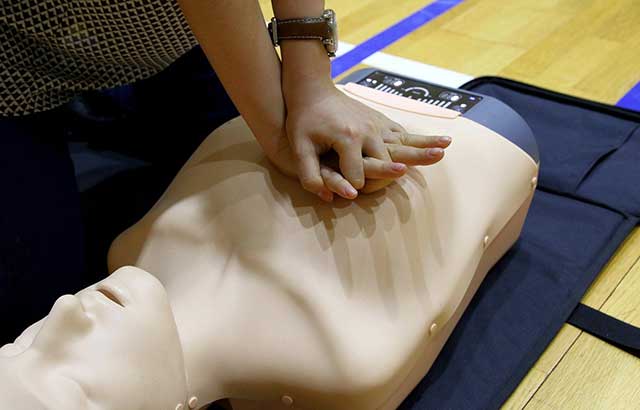Local Hero Uses CPR To Save A Life… On Vacation!
Local cardiologist and community leader, Willie Lawrence, MD saves lives each and every day. Named as he American Heart Association’s 2011 Physician of the Year, Dr. Lawrence works tirelessly to advocate and fulfill the association’s mission to build healthier lives, free of cardiovascular disease and stroke. As a physician, Dr. Lawrence is also an expert at performing CPR, but notes that you don’t have to be a physician to know how to save a life. “It’s a simple technique that everyone should know,” notes Dr. Lawrence.
On February 24, while attending the “White House Community Leaders Briefing on Cardiovascular Health” in Washington, D.C., Dr. Lawrence found himself saving a life outside hospital walls for the first time. Although Dr. Lawrence has been involved in hundreds of in-hospital sudden cardiac arrest saves, this was his first experience outside the hospital setting.
The night before the briefing, he was at dinner when he overheard a commotion at another table in the restaurant. Dr. Lawrence turned to see a woman in her 60s slumped over in her chair. Recognizing that she was unconscious and in trouble, Dr. Lawrence quickly went over and found her pulseless and unresponsive. He immediately began performing Hands-Only CPR while someone else called 9-1-1. As he began CPR, Dr. Lawrence called out for an AED (automated external defibrillator). Unfortunately, no one in the restaurant knew if they had one and if so, where it was located. He continued performing the hands-only technique and miraculously, the woman regained a pulse and became responsive and alert.
A Random Act of Kindness
“Saving someone’s life in this situation is what I’d call a random act of kindness – we do this so much in the hospital, on people we don’t know,” said Dr. Lawrence. “What’s important for family members and friends to realize is that I did something – Hands-Only CPR – that’s really pretty simple. No one else at this woman’s table knew CPR, and that was a potential tragedy in the making.”
It’s also very important to be aware of where an AED may be located in public places. An AED is a computerized medical device that can check a person’s heart rhythm, recognize a rhythm that requires a shock and can advise the rescuer when a shock is needed. It was later discovered that the restaurant indeed had an AED but, unfortunately, none of their employees knew where it was located.
CPR Can Save Lives!
The use of CPR dates all the way back to 1740, yet even today, most Americans don’t know how to perform it. Given properly and immediately to sudden cardiac arrest victims, CPR can save lives.
Anyone can learn CPR – and everyone should! Sadly, 70 percent of Americans may feel helpless to act during a cardiac emergency because they either do not know how to administer CPR or their training has significantly lapsed. This alarming statistic could hit close to home, because home is exactly where 80 percent of cardiac arrests occur. Put very simply: The life you save with CPR is mostly likely to be someone you love.
National CPR Week
This June, in honor of National CPR Week, the American Heart Association is calling on all Americans to learn how to give Hands-Only® CPR by watching a simple one-minute video at www.handsonlycpr.com. Once you have learned CPR, give five people you care about the power to save lives by equipping them to act quickly in a crisis.
Don’t be afraid; your actions can only help. If you see an unresponsive adult who is not breathing or not breathing normally, call 911 and push hard and fast on the center of the chest.
You can also download a free app for your phone to walk you through the simple steps of performing CPR.
Why Learn Hands-Only CPR?
Sudden cardiac arrest is a leading cause of death. Nearly 400,000 out-of-hospital cardiac arrests occur annually in the United States.
- When a teen or adult has a sudden cardiac arrest, survival depends on immediately getting CPR from someone nearby.
- Sadly, 89 percent of people who suffer an out-of-hospital cardiac arrest die because they don’t receive immediate CPR from someone on the scene.
- Most Americans (70 percent) feel helpless to act during a cardiac emergency because they don’t know how to administer CPR or they’re afraid of hurting the victim. Don’t be afraid. Your actions can only help.
Be The Difference For Someone You Love
If you are called on to give CPR in an emergency, you will most likely be trying to save the life of someone you love: a child, a spouse, a parent or a friend.
- 80 percent of sudden cardiac arrests happen in private or residential settings.
- Unfortunately, only 41 percent of people who experience a cardiac arrest at home, work or in public get the immediate help that they need before emergency help arrives.
- Hands-Only CPR has been shown to be as effective as conventional CPR for sudden cardiac arrest at home, at work or in public. It can double or even triple a victim’s chance of survival.
Be The Difference For Someone You Love
If you are called on to give CPR in an emergency, you will most likely be trying to save the life of someone you love: a child, a spouse, a parent or a friend.
- 80 percent of sudden cardiac arrests happen in private or residential settings.
- Unfortunately, only 41 percent of people who experience a cardiac arrest at home, work or in public get the immediate help that they need before emergency help arrives.
- Hands-Only CPR has been shown to be as effective as conventional CPR for sudden cardiac arrest at home, at work or in public. It can double or even triple a victim’s chance of survival.
Disco Can Save Lives
Hands-Only CPR has just two easy steps: If you see a teen or adult suddenly collapse, (1) Call 9-1-1; and (2) Push hard and fast in the center of the chest to the beat of the disco song “Stayin’ Alive.”
- According to the American Heart Association, people feel more confident performing Hands-Only CPR and are more likely to remember the correct rhythm when trained to the beat of the disco classic “Stayin’ Alive.”
- “Stayin’ Alive” has more than 100 beats per minute, which is the rate you should push on the chest during CPR.










